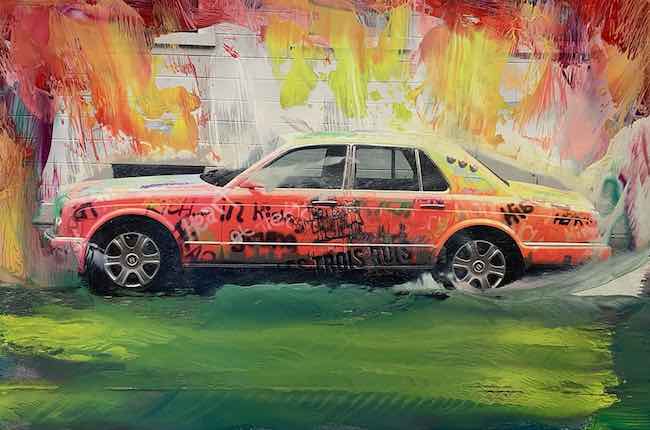L’attitudine sperimentatrice appartiene a molti artisti contemporanei, in special modo a quelli che hanno alle spalle una lunga esperienza in settori professionali differenti da quello specifico dell’arte grazie alla quale hanno la possibilità di mescolare tecniche e punti di vista meno pittorici a una creatività che sente il bisogno di sconfinare e di oltrepassare la tradizione anche attraverso supporti differenti dalla tela, ma al contempo si ispirano proprio alle tecniche del lontano passato per riattualizzarle al presente e adeguarle alle esigenze contemporanee. L’artista di cui vi racconterò oggi, dinamico ed eclettico ingegnere ma artista per vocazione interiore, appartiene a questa categoria di creativi.
L’eclettismo creativo è entrato prepotentemente nel mondo dell’arte del Ventesimo secolo poiché gli artisti di quel periodo dinamico e rivoluzionario non riuscivano a restare all’interno dei confini delineati come invece avevano fatto i loro colleghi dei secoli precedenti; in particolar modo alcuni movimenti mostrarono la necessità di andare oltre il predominio della pittura e della scultura per trasformare in arte anche altre forme espressive emergenti che andavano prendendo sempre più spazio all’interno della società moderna. Intorno agli anni Venti del Novecento in Germania fu fondata una scuola di arte, architettura e design che prese il nome di Bauhaus e si pose come obiettivo quello di essere un riferimento per tutti quei movimenti innovativi orientati al dialogo tra varie forme di espressione, in particolar modo quelli legati al Razionalismo e volte a trovare un legame tra tecnologia e arte. Il loro percorso esplorativo fu essenziale poiché in qualche modo riprese l’approccio aperto e sinergico dell’Art and Crafts di qualche decennio prima, attingendo anche ad antiche tecniche artigianali che divenivano base per l’inclusione nelle nuove scoperte tecnologiche. Contemporaneamente il Surrealismo, raccogliendo l’eredità irriverente e trasgressiva del Dadaismo, si spinse ben oltre mantenendo da un lato un tipo di approccio pittorico di grande valore figurativo ma esplorando il mondo inquietante degli incubi, e dall’altro coinvolgendo nel movimento anche esponenti del cinema e della fotografia, trasformandosi a sua volta in un similare, seppur discordante in quanto a tematiche, approccio rispetto alla Bauhaus in cui coinvolgere anche arti cosiddette minori eppure in grado di conquistare una fetta sempre più ampia di appassionati. Tuttavia per assistere a una vera e propria interazione non solo dei concetti e delle linee guida, ma anche del dialogo e della fusione tra materiali più classici e altri più innovativi è necessario attendere qualche anno, quando cioè le ultime definizioni e delimitazioni cominciarono a essere abbattute per lasciar spazio a nuove esplorazioni espressive che si concretizzarono con l’inserimento di materiali inediti dell’Informale Materico e dell’Arte Povera, con l’introduzione nell’opera di frammenti fotografici o di cartelloni pubblicitari come nella Pop Art di Mimmo Rotella e infine nella Digital Art in cui addirittura la tecnologia diviene protagonista principale e solo in un secondo momento il creativo a volte decide di agire manualmente sul risultato finale.
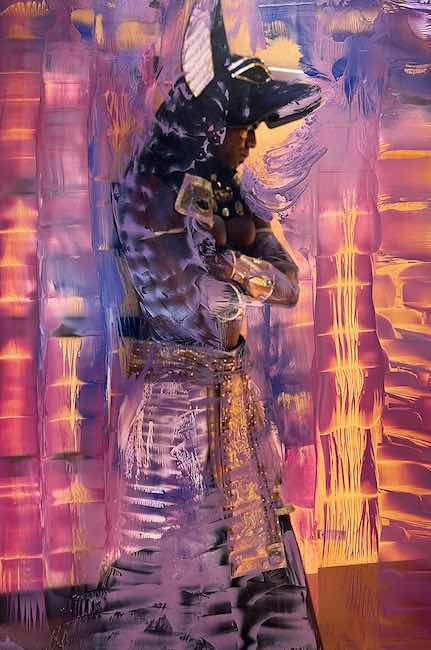
L’ingegnere Panto Trivkovic, nato in Bosnia Erzegovina ma residente da molti anni a Vienna, dà vita a una sua personale esperienza creativa in cui la tendenza alla tridimensionalità che gli viene dall’esperienza professionale si concretizza attraverso lo studio e l’utilizzo di una tecnica che ha radici molto antiche, l’encausto o pittura a cera calda con cui infonde concretezza e struttura alle opere pittoriche o fotografiche su cui sceglie di agire; sì perché l’eclettismo di questo particolare artista si manifesta non solo sul supporto utilizzato per realizzare i suoi dipinti o i suoi disegni bensì anche nella passione per la fotografia la quale nel suo caso si trasforma in ulteriore mezzo di esplorazione e di sinergia tra differenti tecniche. L’approccio aperto e curioso lo induce a mescolare le sue conoscenze così come la sua innata tendenza all’esplorazione della terza dimensione lo spinge a cercare una materia più consistente del classico colore, come la pittura a cera calda, in cui il colore e lo spessore della cera strutturano le superfici in maniera più viscosa, più incisiva, donando pertanto alle opere un effetto prospettico in lieve rilievo e dunque mettendo in qualche modo il supporto in dialogo con l’esterno. La gamma cromatica è decisamente espressionista perché l’irrealtà dei colori si lega al mondo emozionale di Panto Trivkovic, si armonizza con la sua capacità di andare oltre e di scoprire, mettendoli in evidenza, quei dettagli rilevanti che costituiscono l’essenza stessa del concetto che desidera esprimere; la pastosità della superficie diventa dunque coriacea, concreta, proprio perché, sembra suggerire l’artista, non esiste concetto senza una base solida a cui aggrapparsi, perché a volte l’incisività del messaggio ha bisogno di luci e ombre che provengono dall’alternarsi tra vuoti e pieni, tra alti e bassi in grado di infondere nello sguardo dell’osservatore la necessità di entrare in quegli spazi lasciandosene affascinare.
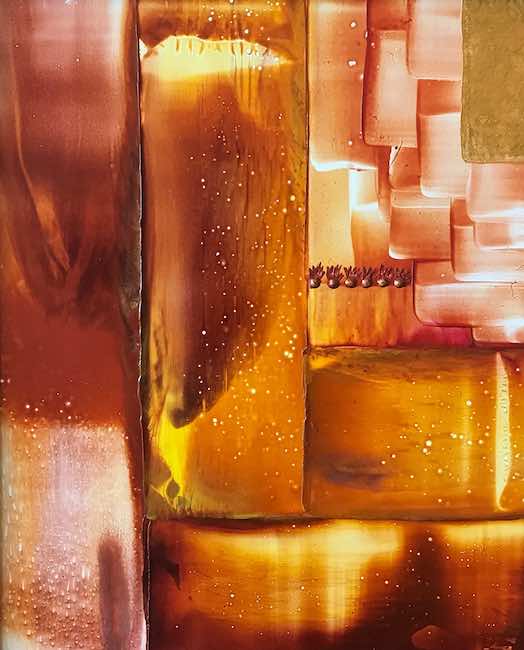
Nell’opera The Guardians il colore oro, declinato in varie tonalità a volte più gialle a volte più rosate, sembra costituire delle pieghe simili a piccole porte che proteggono, esattamente come indicato dal titolo, un’interiorità spesso troppo delicata per essere svelata, preziosa e dunque in qualche modo necessitante di essere avvolta in quella coltre dietro cui difendersi da ingerenze esterne che potrebbero ferirla. Gli strati della pittura rappresentano quei livelli funzionali a tutelarsi e che verranno aperti solo a chi sarà in grado di meritare di scoprire la reale sostanza di ciò che si nasconde dietro di essi.
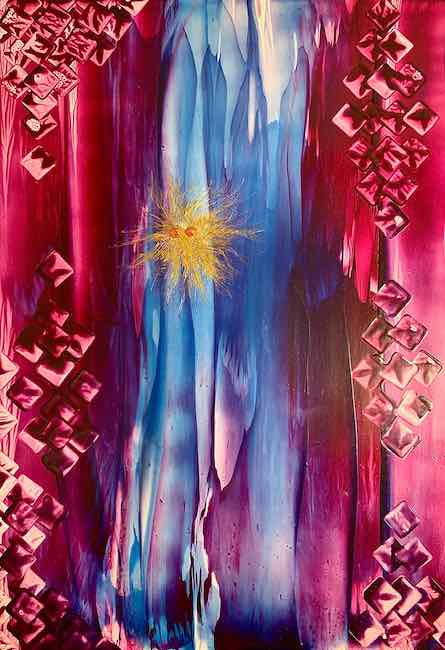
E ancora in The Privilege Trivkovic narra di uno scorcio quasi magico che sembra indicare la dimensione in cui riesce a entrare chi ha la capacità di ascoltare le energie sottili intorno a sé, quelle preziose indicazioni e suggerimenti volti a spingere l’individuo verso un contatto profondo con quel mondo intuitivo ed emozionale troppo spesso sepolto sotto un pragmatismo necessario alla sopravvivenza nella giungla contemporanea. L’encausto sottolinea ed enfatizza i cristalli di magia espressi dal magenta che contraddistingue l’anima, e che emergono dalla sottostante base della medesima tonalità tanto quanto convogliano lo sguardo in quell’interno che sembra condurre verso la fluidità delle possibilità, di quella consapevolezza della coscienza di poter modificare il proprio percorso in virtù di quel lasciarsi andare all’introspezione e al contatto con le misteriose e sottili energie che ruotano intorno all’individuo.

Quando invece avverte l’esigenza di abbandonare il mondo del concetto Panto Trivkovic tende verso la figurazione avvalendosi di tecniche differenti come la fotografia che riesce a plasmare e a modificare sulla base del suo sentire, come in Winter Parallels dove emerge la sua attitudine all’ammirazione della schematicità strutturale che caratterizza la sua professione di ingegnere; in questa fotografia stampata su carta Hahnemühle, tra le più antiche e pregiate carte prodotte in Germania, la prospettiva crea un effetto ottico in cui l’illusione è quella di trovarsi davanti a una composizione di Astrattismo Geometrico dove invece è solo la natura, e l’intervento dell’uomo, a essere assoluta e reale protagonista dell’affascinante scatto dell’artista.
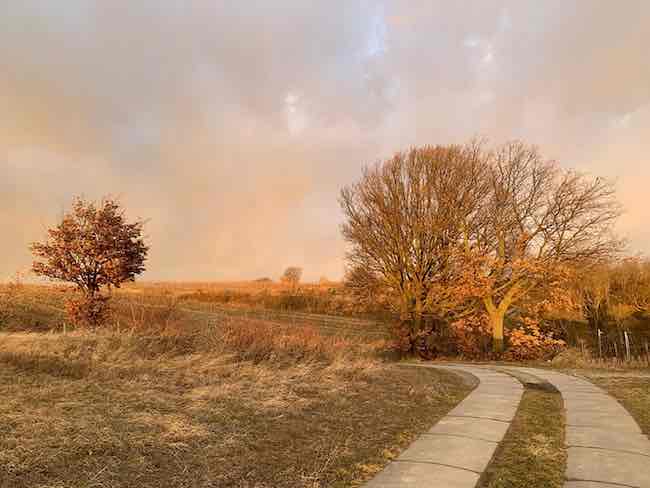
O ancora in Autumn light la prospettiva genera una visione ammaliante e inedita del paesaggio rurale, dove la luce trasforma le tonalità cromatiche della natura in un mondo dorato e morbido dentro il quale lo sguardo di Trivkovic si perde e si emoziona al punto di voler immortalare quel perfetto equilibrio tra linee del sentiero e immobilità dorata degli alberi che sembrano offrirsi al lieve calore solare che contraddistingue la stagione autunnale.
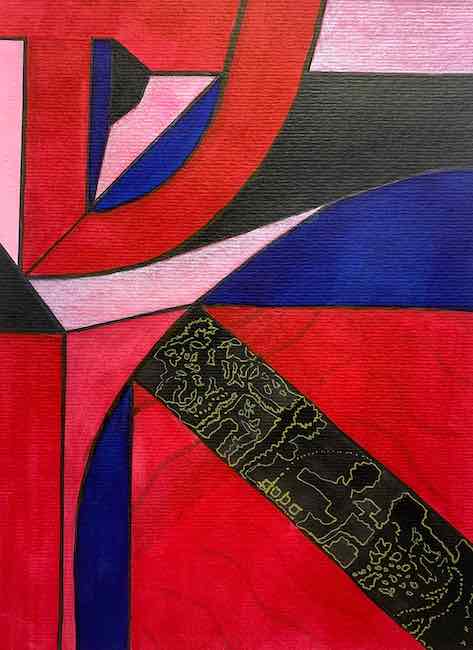
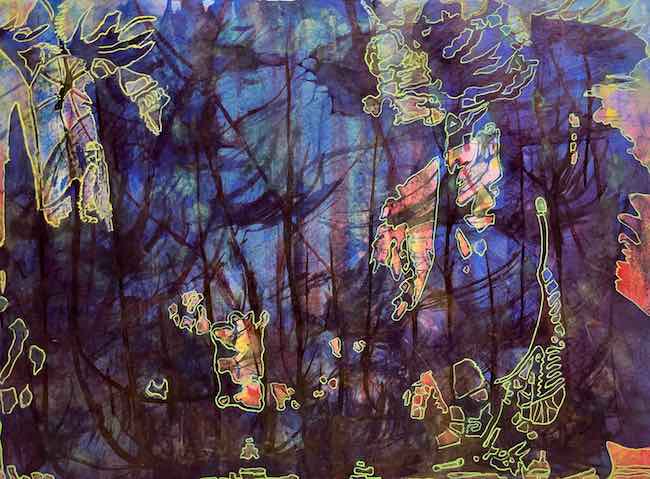
Ma l’eclettismo di Panto Trivkovic lo spinge a misurarsi anche con altre tecniche artistiche come l’inchiostro su carta e l’acquarello, grazie alle quali può confermare e assecondare la mutevolezza che lo rende insofferente alla ripetitività o all’uniformità di messaggio creativo, perché fare arte per lui significa uscire dalle regole e appropriarsi della libertà di scegliere, di volta in volta, l’approccio più affine alla sensazione che sente l’impulso di esprimere. Nel 2018 ha aperto la galleria PantoArt, suo studio ma anche spazio espositivo di cui è direttore artistico; Panto Trivkovic espone regolarmente in Austria e all’estero – USA, Russia, Cina, Svizzera e Italia -, le sue opere sono pubblicate in importanti riviste d’arte, è stato finalista in molteplici concorsi artistici e fotografici ed è membro dell’Associazione Professionale di Belle Arti dell’Austria, dove è Leader della Sezione Foto e Multimedia, e di International Encaustic Artists negli Stati Uniti.
PANTO TRIVKOVIC-CONTATTI
Email: office@pantoart.at
Sito web: https://www.pantoart.at
Facebook: https://www.facebook.com/panto.trivkovic
Instagram: https://www.instagram.com/iampantoart/
The three-dimensional vision of Panto Trivkovic, poised between innovation and tradition
The experimental attitude belongs to many contemporary artists, especially those who have a long experience in professional sectors other than the specific field of art, thanks to which they have the possibility of mixing less pictorial techniques and points of view with a creativity that feels the need to trespass and go beyond tradition, even through supports other than canvas, but at the same time they are inspired by the techniques of the distant past to bring them up to date with the present and adapt them to contemporary needs. The artist I am going to tell you about today, a dynamic and eclectic engineer but an artist by inner vocation, belongs to this category of creatives.
Creative eclecticism entered the art world of the 20th century in a big way because the artists of that dynamic and revolutionary period were not able to remain within the delineated boundaries as their colleagues of previous centuries had done. In particular, certain movements showed the need to go beyond the dominance of painting and sculpture to transform other emerging forms of expression that were gaining more and more space in modern society into art. Around the 1920s was founded in Germany a school of art, architecture and design that took the name Bauhaus and set itself the goal of being a reference for all those innovative movements oriented towards dialogue between various forms of expression, especially those linked to Rationalism and aimed at finding a link between technology and art. Their path of exploration was essential as it somehow resumed the open and synergetic approach of Art and Crafts of a few decades earlier, also drawing on ancient craft techniques that became the basis for inclusion in new technological discoveries. At the same time, Surrealism, picking up the irreverent and transgressive inheritance of Dadaism, went much further, on the one hand maintaining a type of pictorial approach of great figurative value but exploring the disturbing world of nightmares, and on the other hand also involving exponents of cinema and photography in the movement, transforming itself into a similar, albeit discordant in terms of themes, approach compared to Bauhaus in which it also involved so-called minor arts, yet capable of conquering an ever-widening slice of enthusiasts.
However, in order to witness a true interaction not only of concepts and guidelines, but also of dialogue and fusion between more classical materials and more innovative ones, it was necessary to wait a few years, that is, when the last definitions and delimitations began to be broken down to make way for new expressive explorations that took concrete form with the inclusion of previously unseen materials of the Materic Informal Art and Arte Povera, with the introduction of photographic fragments or billboards into the artwork, as in the Pop Art by Mimmo Rotella, and finally in Digital Art in which even technology becomes the main protagonist and only later does the creative artist sometimes decide to act manually on the final result. Engineer Panto Trivkovic, who was born in Bosnia-Herzegovina but has lived in Vienna for many years, gives life to his own personal creative experience in which the tendency towards three-dimensionality that comes from his professional experience is realised through the study and use of a technique that has very ancient roots, encaustic or hot wax painting, with which he imbues the pictorial or photographic works he chooses to act on with concreteness and structure; yaes, because the eclecticism of this particular artist is manifested not only in the medium used to create his paintings or drawings, but also in his passion for photography, which in his case becomes a further means of exploration and synergy between different techniques. His open and curious approach leads him to mix his knowledge, just as his innate tendency to explore the third dimension drives him to seek out a more consistent material than classic colour, such as hot wax painting, in which the colour and thickness of the wax structure the surfaces in a more viscous, more incisive manner, thus giving the artworks a perspective effect in slight relief and thus somehow placing the support in dialogue with the outside world.
The chromatic range is decidedly expressionist because the unreality of the colours is bound up with Panto Trivkovic’s emotional world, harmonising with his ability to go beyond and discover, by highlighting them, those relevant details that constitute the very essence of the concept he wishes to express; the pastiness of the surface thus becomes leathery, concrete, precisely because, the artist seems to suggest, there is no concept without a solid base to cling to, because sometimes the incisiveness of the message needs light and shadow coming from the alternation of full and empty spaces, highs and lows capable of instilling in the observer’s gaze the need to enter those spaces and be fascinated by them. In the painting The Guardian, the colour gold, declined in various shades, sometimes more yellow, sometimes more pink, seems to constitute folds similar to small doors that protect, exactly as indicated by the title, an interiority that is often too delicate to be revealed, precious and therefore in some way needing to be wrapped in that blanket behind which to defend itself from external interferences that could injure it. The layers of painting represent those functional layers to protect oneself and that will only be opened to those who are able to deserve to discover the real substance of what is hidden behind them. And again in The Privilege Trivkovic tells of an almost magical foreshortening that seems to indicate the dimension into which can enter those who have the ability to listen to the subtle energies around them, those precious indications and suggestions aimed at pushing the individual towards a profound contact with that intuitive and emotional world too often buried under a pragmatism necessary for survival in the contemporary jungle.
The encaustic highlights and emphasises the crystals of magic expressed by the magenta that characterises the soul, and that emerge from the underlying base of the same tonality as much as they channel the gaze into that interior that seems to lead towards the fluidity of possibilities, of that awareness of the consciousness of being able to modify one’s path by virtue of that letting oneself go to introspection and contact with the mysterious and subtle energies that revolve around the individual. When, on the other hand, he feels the need to abandon the world of the concept, Panto Trivkovic tends towards figuration, using different techniques such as photography, which he manages to mould and modify on the basis of his feelings, as in Winter Parallels where emerges his aptitude for admiring the structural schematicism that characterises his profession as an engineer; in this photograph printed on Hahnemühle paper, one of the oldest and most valuable papers produced in Germany, perspective creates an optical effect in which the illusion is that of being in front of a composition of Geometric Abstractionism where instead it is only nature, and man’s intervention, that is the absolute and real protagonist of the artist’s fascinating shot. Or again in Autumn light, the perspective generates a bewitching and unprecedented vision of the rural landscape, where the light transforms the chromatic tones of nature into a soft, golden world within which Trivkovic’s gaze loses itself and gets so excited that he wants to immortalise that perfect balance between the lines of the path and the golden immobility of the trees that seem to offer themselves to the slight solar warmth that characterises the autumn season.
But Panto Trivkovic’s eclecticism also pushes him to measure himself with other artistic techniques such as ink on paper and watercolour, thanks to which he can confirm and indulge the mutability that makes him intolerant of repetitiveness or the uniformity of creative message, because making art for him means breaking the rules and appropriating the freedom to choose, from time to time, the approach most akin to the feeling he feels the urge to express. In 2018, he opened the PantoArt gallery, his studio but also an exhibition space of which he is the artistic director; Panto Trivkovic regularly exhibits in Austria and abroad – USA, Russia, China, Switzerland and Italy -, his artworks are published in leading art magazines, he has been a finalist in multiple art and photography competitions and is a member of the Professional Association of Fine Artists of Austria, where he is Leader of the Photo and Multimedia Section, and of International Encaustic Artists in the USA.


